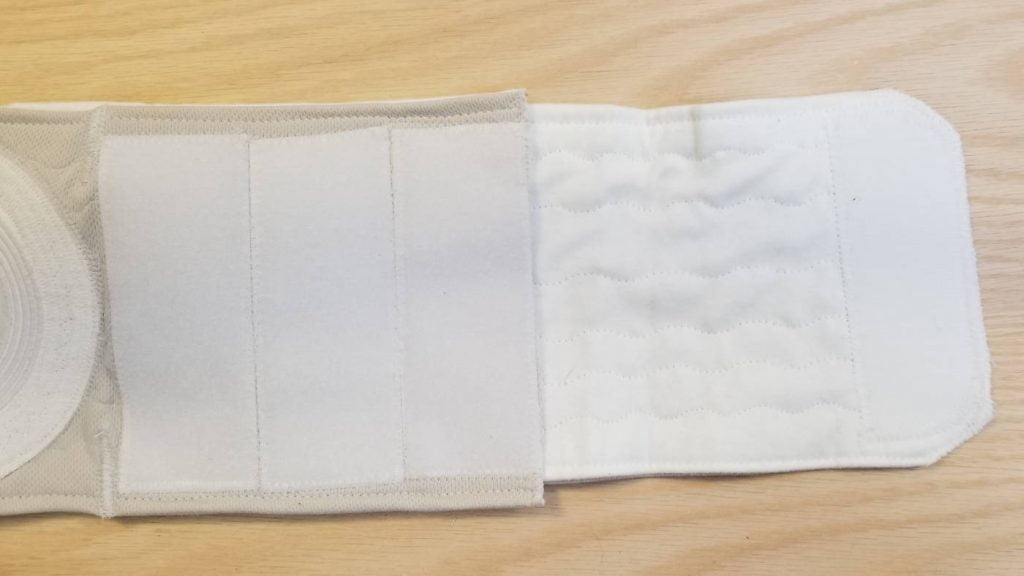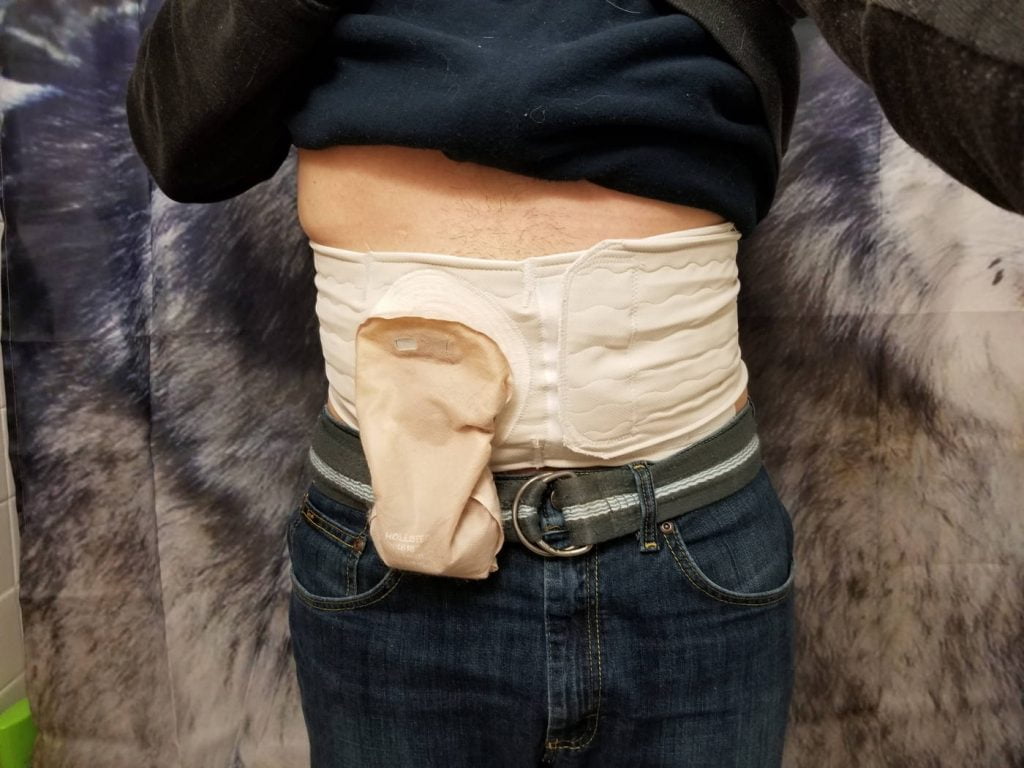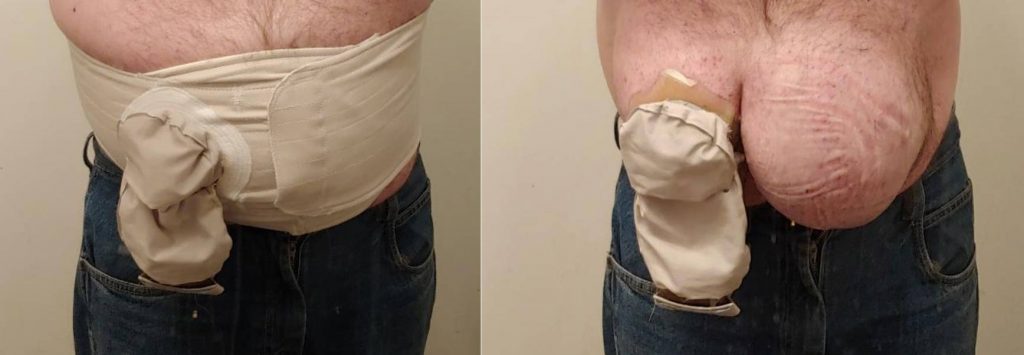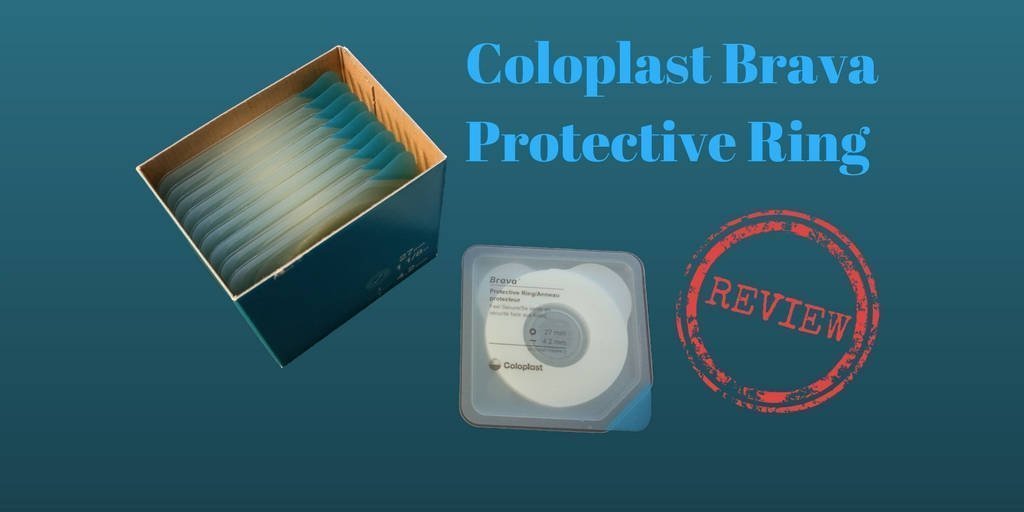Ostomy surgery entails some risk, and one of those risks are parastomal hernias.
In this review, I’ll be looking at the Hernia Helper!
Disclosure: The Hernia Helper I’ve been using was graciously provided free of charge by the manufacturer for this review. They played no role in shaping the content of this review, although I did request a few photos to help illustrate the product being used for a large hernia.
Table of Contents
About the Hernia Helper
Product name: Hernia Helper
Manufacturer: Hernia Helper
Product #: n/a (custom made)
Dimensions: Varies
Quantity per package: 1

The Hernia Helper is a custom-made abdominal hernia support and/or parastomal hernia prevention belt that was created when the company’s founder, a colostomate, developed parastomal hernias.
It’s made of a non-stretch, woven cotton that has a stiffer panel on the front to help support and prevent hernias. The ends of the belt have Velcro, which is used to secure the belt in place.

Along the back of the belt are two, vertical strips of plastic that have been inserted into the belt itself. These help to provide stability and prevents the belt from bunching (which is a common complaint with tall belts and wraps).
The only measurement I needed to give with my waist size at stoma level, but I also let Gord (the company’s founder) know my flange size.
There is an opening where your stoma would stick out from on the front of the panel that is cut oval, so it becomes round when stretched. I will note that the opening is designed to sit on top of your flange, not around it; this design adds more support and helps to flatten out the appliance.

If you’re Canadian, then you’ll be happy to know that the Hernia Helper is a product of Canada :)
Using this Product
This style of hernia belt is pretty straightforward and uncomplicated.
If you don’t have a hernia and simply want prevention support:
While you have your ostomy bag on and exposed, you’ll want to feed the tail end of the bag through the opening while making sure that as much of the bag is pulled out.
Be mindful about centering your stoma to the middle of the opening, as you don’t want your stoma to be squished or rub up against the sides of the opening.
As mentioned previously, the opening is designed to go over your flange (the plastic connectors on a two-piece appliance) rather than around it, so don’t try to force it around your flange!

Once you have the belt where you want it, you’ll wrap it around your abdomen and secure it in place with the Velcro, making it tight enough to offer support, but not so tight that it’s uncomfortable.
Because this belt doesn’t stretch,
If you do have a hernia and want to support it:
If you already have a hernia, it’s often best practice to lay flat on your back for several minutes so that the hernia can flatten as much as possible before applying the belt (which can do while laying down).
The same steps as above will apply, and your hernia should be well supported until you remove the belt.
My Experience
Wearing the Hernia Helper all day and night has been a mostly positive experience.

I love the support it offers, especially as my bag fills up, and it gives me assurance when I’m doing any kind of lifting.
The fabric does tend to absorb sweat, rather than wicking it away, and it does feel much hotter around the abdomen when you’re wearing it during the hot, summer months. On the flip side, it helps to keep warmer during the winter, so I guess there’s a trade-off there.
Because of how the face of the belt sits on my flange, I find that using a pouch cover is difficult to impossible because the pouch cover has nothing to hang onto (usually, it hangs off the floating-flange of my Hollister appliance).
This is a non-issue if you wear opaque bags or keep your appliance under clothing, but it is something that I’ve had to work around.
Since the fabric used is not stretchy, I also find that it tends to get loose if I’m doing anything that involved stretching upwards or when I tighten up my core. I emailed Hernia Helper to ask about this and Gord said that he finds that stiffer fabric helps to support larger hernias better, but entertained the idea as part of a future design.
My biggest complaint about this belt is that I often find that my stoma often bleeds a little when I’m wearing it. I’ve determined that it’s likely being caused when the belt shifts a little and the opening of the belt rubs against my stoma.
This wouldn’t be something that happens with products that have an opening that goes around the base of the flange, but you do lose an element of support with those products.
Supporting a Large Hernia
Because I don’t have a hernia but wanted to include some photos of the product being used by someone who does, I had contacted Gord at Hernia Helper to see if he could send some.
He did, so I’m happy to present what the Hernia Helper looks like when supporting a large hernia (and it really does make a difference!).



Conclusion
At the time of this writing (Dec 2018), the Hernia Helper is available to order for $140 Canadian or US$120. Shipping is included in the price.
This is on the high-end for hernia belts, but most private insurance should cover it. Being that shipping is included in the price, this might not be as expensive as it seems, and because private insurance doesn’t tend to cover shipping charges, you’ll likely have nothing to pay for out of pocket.
Customization of each belt can be requested at no extra charge, so if you need one with a hole that’s higher or lower, it can be done.
Pros:
- Custom-made.
- Comfortable to wear through various activities.
- Can be adjusted for a tight or loose fit.
- Works very well to support large hernias.
- Can be used to prevent hernias
- Available in white, tan, and black.
- Made in Canada, eh!
Cons:
- Has no stretch, so it doesn’t conform around the entire abdomen like some other products do; the non-stretch material may help to support a hernia, so this may not be a negative point.
- Expensive (but the price includes shipping and private insurance will likely cover the cost of the belt)
- The opening is a “tight fit”.
- Doesn’t have a “factory finish” (being hand-made, this is expected and can also be desired).
Recommended
In my many months of using the Hernia Helper, I found that it’s been comfortable and effective for hernia prevention. It also appears to work very well to support existing abdominal hernias.
While a hernia belt isn’t something that all ostomates consider, the risk of a parastomal hernia is high enough that all ostomates should be looking into a hernia prevention belt such as this one.
For more information, please visit the Hernia Helper website at: www.herniahelper.ca
Question: Have you used this hernia belt? Share your experience below.





Every single stomal hernia support belt I’ve used buckles along the top where there is hard plastic is and you can see it through my clothing
Hi Lori, have you used any with softer material (not hard plastic)? They don’t offer as much support, but could work better in that situation.
I didn’t have as much success with my Hernia Helper. I could tell it was well made and my hopes were initially high, but the width of the belt (i.e., vertically, from top to bottom) was too narrow. The belt ends just above and below the flange opening. So it didn’t support the top & bottom of my huge hernia, and the bottom (which was quite rigid because it’s actually the bottom of the reinforced opening) rubbed against my skin and created an open sore. So obviously I had to stop wearing it. I think this could be prevented by getting more detailed measurements, like how many inches you need on top & bottom of the opening. In the top photo of you wearing the belt there seems to be more material, at least above the opening. I have hernia belt envy!
Also should mention that the ‘stays’ on the sides are better than those made by Nu-Hope, but still didn’t prevent bunching. I suspect there’s no solution to this, for women. As you can see in the photos, most men have straight torsos. But women are often more hourglass-shaped. So belts bunch up and form a thin, tight, and very uncomfortable constriction around the sides and back. I haven’t yet found a belt that doesn’t do this. But still looking …
Joan, that’s disappointing to hear. One advantage to having a hernia belt fitted by a stoma nurse, is getting those extra measurements that will help to support larger hernias. With a “one-size-fits-all" design, there’s not much room to accomodate every body, but I’m curious if you’ve been able to contact Hernia Helper to see if a new belt (to your requirements) can be done up. Good luck!
Yes, I’m really happy to report that the owner at Hernia Helper got in touch with me and was very concerned. He kindly offered to make me another one and I have to tell you that it’s the best hernia belt I’ve tried (and I’ve tried them all, sometimes multiple times each). I’ve worn it daily for over a week now and it HASN’T BUNCHED UP!! This is the only belt I’ve ever worn that hasn’t bunched. It’s the first time in years I haven’t been in pain or discomfort wearing a belt. He also added more fabric above and below the opening, so it feels very supportive now. I’d highly recommend the Hernia Helper belt, in particular to women with “jelly bellies" for whom bunching is a problem. Make sure you mention that problem and ask for extra stays, and as always, give careful measurements if you don’t have a stoma nurse to do it for you.
Joan, that’s wonderful! Thank you for letting us know. It’s great that they were able to help you directly with this.
As usual always a great job Eric. Wishing you and the family a happy and healthy New Year, Aileen